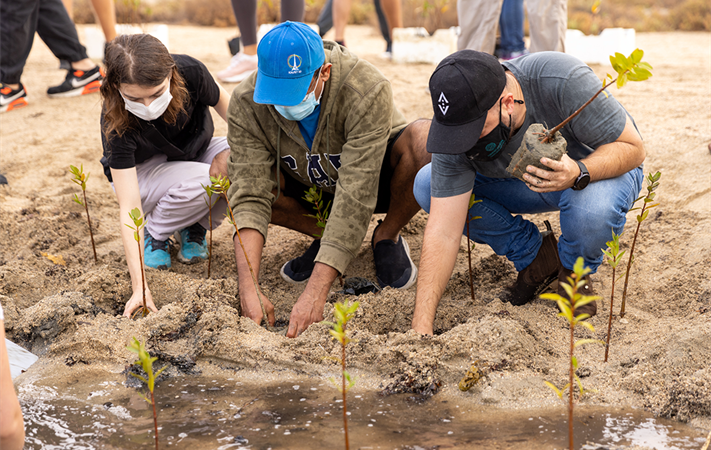Mangroves have endured the test of time, and are capable of living in water that is 100 times saltier than what other plants can withstand. They have flourished in some of the toughest environmental surroundings for millions of years.
 KAUST community members plant mangrove trees in the University's coastal wetlands. Image Credit: KAUST.
KAUST community members plant mangrove trees in the University's coastal wetlands. Image Credit: KAUST.
During this period, mangroves have thrived worldwide, with their seeds, fruits and saplings capable of floating for months before forming roots. In just 10 years, one seed can create a whole colony that, in turn, can develop new habitats and land in and around it.
These features make the mangroves an important ecosystem to safeguard.
These amphibious plants, with one "foot" in the water and the other on land, offer food and home to numerous animals such as crabs, birds, lizards, mollusks, shrimp, stingrays, fish and snails.
Blue Carbon Sinks
Mangroves are gradually being seen as key players in the combat against climate change.
KAUST is home to a thriving mangrove forest spanning more than 110 hectares, including a Nature Conservation Area. Compared to other terrestrial forests, the extensive network of mangrove roots provides an ample opportunity for carbon to sink.
Dr. Mohamed Omar, Environmental Protection Manager, Department of Health, Safety, and Environment (HSE), KAUST
KAUST Professor Dr. Carlos Duarte added, "Mangrove forests rank among the most intense carbon sinks in the biosphere, locking much more carbon into their soils than tropical forests. However, when disturbed, the carbon in the soils may be emitted as CO2, so there is opportunity for climate benefits in both avoiding mangrove losses and restoring lost mangroves."
Mangroves are called blue carbon sinks due to their association with coastal regions; "blue" denoting water, in contrast to "green" carbon that is linked to land-based trees.
Offsetting Carbon During the 2022 Winter Enrichment Program
Although conservation and improvement of mangrove forests have been a crucial part of KAUST since its formative days, the planting of mangroves in the winter of 2022 in KAUST's Nature Conservation Area was a project that was started to bring awareness of the negative ecological effect associated with travel-connected carbon emissions.
As part of the 2022 Winter Enrichment Program (WEP) at KAUST, Event Chair and KAUST Professor Dr. Peiying Hong sought the assistance of the HSE Department to make the program more sustainable.
Every year, WEP aims to enrich our students' learning experience by inviting globally renowned speakers to share their perspectives in person at KAUST. This incurs a large carbon dioxide footprint. The WEP theme for 2022 was resilience, and a main focal message of the program was to explore ways to mitigate various tipping points, such as climate change and exhibit resilience. Hence, we wanted to stay true to our theme.
Dr Peiying Hong, Professor and Event Chair, 2022 Winter Enrichment Program, KAUST
The HSE team projected that the 2022 WEP speakers covered approximately 200,000 km in long-distance travel. After having computed their carbon emissions, the WEP team, in partnership with HSE and Facilities Management (horticulture), planned to cultivate more than 200 mangrove plants to not only balance their emissions over time but also increase awareness regarding their abilities to capture carbon.
Key Learnings and Progress
From the time KAUST took up the task of being the custodian of mangroves, certain crucial findings have been highlighted.
We discovered that Red Sea mangroves, which rank toward the low end in terms of organic carbon sequestration in their soils and biomass, activate an additional mechanism—an alkalinity emission from dissolution of the carbonate in the bedrock they grow on, which we estimate amplifies their carbon removal capacity by 23 times.
Dr. Carlos Duarte, Professor, KAUST
The mangrove conservation efforts of KAUST have also exposed how effectively and quickly mangrove colonies can grow when preserved correctly.
"Our mangrove forest has grown around 45 percent between 2005 and 2020," Omar said. "This remarkable growth is a combination of natural colonization, replantation efforts, and environmental policy intervention."
Looking Ahead
Mangrove cultivation and restoration projects signify an economical way of improving carbon capture capacity, particularly if planned and implemented correctly, as has been the situation at KAUST thus far.
Hong said, "The planting of mangroves in this instance is more beneficial than planting land-based trees, which require freshwater irrigation. Mangroves do not need irrigation water since they are planted directly in the coastal areas of the sea."
Already part of the natural background of numerous communities worldwide, mangroves act as a non-invasive carbon alleviation strategy, a nature-based answer that plays an important role in the future.
Mangroves are definitely one of the ways to achieve our carbon mitigation goals, not simply because they sequester carbon, but also because they offer huge benefits for coastal protection and many other advantages, including fishery enhancement. Over the past decade, the level of awareness on blue carbon, and specifically the role of mangroves, has grown. This education must continue, both at policymaker and public levels to boost engagement and uptake of mangrove projects.
Dr. Carlos Duarte, Professor, KAUST
Seaweed sinks deep, taking carbon with it
Video Credit: KAUST